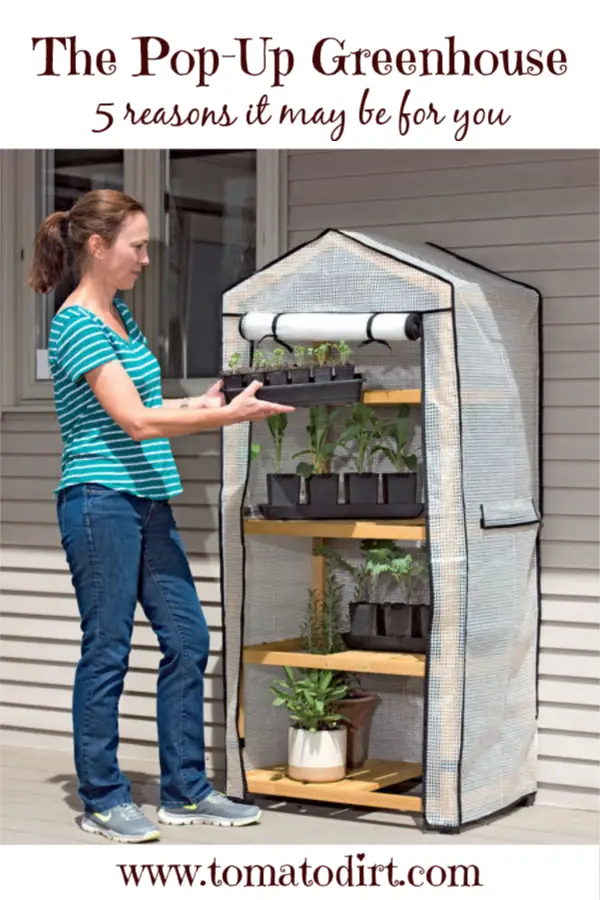Pop-Up Greenhouse for Tomatoes: Is It for You?
Since 2010, Tomato Dirt has garnered 4.8+ million views, making it the web’s leading online source for growing tomatoes in the home garden. Award-winning writer and Tomato Dirt owner Kathy Widenhouse has helped thousands of home gardeners grow healthier tomatoes. Be one of them when you get Tomato Dirt’s Growing Guide here.
Updated 1.23.24
A pop-up greenhouse is an ideal alternative to a traditional attached or freestanding structure, particularly for the home gardener or gardening hobbyist.
It is collapsible and movable, providing temporary, seasonal protection that can be used year after year. Pop-ups, also called “mini-greenhouses,” come in a range of sizes.
One of their main benefits is convenience. You can set up one when you need it and then take it down and pack it away when you’re done with it. In contrast, a typical greenhouse is much more permanent – not to mention a more significant cost investment.
In addition, you can set up a mini anywhere you like – even in the smallest space. This allows you to take advantage of sunlight positioning. You can even use it for overnight or frost protection for plants that are already set out in the garden. They are available in all shapes, sizes, and types.
How pop-ups are like other greenhouses
Like other greenhouses, pop-ups can extend your growing season. You can use them to start tomato seeds, rather than starting them indoors. You can also protect tomato seedlings in a pop-up when you set them out to harden off, use a mini to propagate cuttings, and even set plants inside them to overwinter when fall comes.
And in the same way as traditional greenhouses work, pop-ups take advantage of solar heat during the day. The difference between the two types is in the type of material used for its sides. Typical greenhouse walls are made of glass or rigid plastic. Most pop-up walls are made of sturdy, flexible UV-resistant clear plastic to let light in. Gro-Tec™, a durable UV-resistant and waterproof material, is increasingly used in pop-ups. Gro-Tec diffuses and scatters light, which reduces excess light on upper leaves and increases the amount of light reflected onto lower leaves. (Too much direct sunlight on the upper leaves can overheat the plant.)
Pop-ups have a screened, zippered vent opening (or more than one, depending on the size of the structure), to allow air to circulate during the day, especially when the sun is bright and temperatures rise. Vents can also be closed to keep in humidity or at night when outside air is cooler. Most pop-ups come with stakes (to anchor the structure) and storage bag (so you can stow it away during the off-season.)
How a pop-up is different than frost covers
A pop-up lets in more light and acts as a greenhouse. In contrast, most frost cover protective pop-up structures do not have clear sides.
A couple of extras help your pop-up work even better
Heater. Set a small space heater in your pop-up overnight during frosty weather to keep temperatures consistent.
Fan. Use a portable fan inside the pop-up to keep air moving around. This can help strengthen tomato stems, encourage pollination, and prevent fungus, damping-off, and mildew.
Advantages of a Pop-Up Greenhouse
Convenience. A pop-up greenhouse is easy to set up and can be disassembled, collapsed, and stored over the winter.
Cost. Pop-ups are considerably less expensive than traditional freestanding and attached greenhouses. Plus, since they are smaller, they don’t need their own heating, cooling, and watering systems.
Versatility. Pop-ups are available in different sizes.
Mobility. Because they’re collapsible, pop-ups can easily be moved from one place to another.
Impermanence. Pop-ups are not a permanent addition to your home and can be stored in the off-season.
Disadvantages of a Pop-Up Greenhouse
Weight. Pop-ups are lightweight. Your pop-up may need to be anchored or otherwise secured if you live in a windy area or if it is placed on an exposed patio, deck, side of the house, or against another vulnerable structure. (Most come with stakes.)
Size. As in so many cases, one gardener’s advantage is another’s disadvantage. This is most definitely the case with a pop-up’s size. This kind of greenhouse may not be for you if you need considerable space in which to grow tomato seedlings (and other seedlings) or if you plan to harden off a large number of plants.
How to know if a pop-up greenhouse is for you
If more than one of the following is true for you, then you may want to consider a pop-up or mini greenhouse.
- You need temporary greenhouse space in the spring and/or fall.
- You are short on garden space.
- You would like an easy or portable way to protect plants from frost.
- You would like a simple way to overwinter plants.
Pop-Up Greenhouse Options
Clear Farmhouse Greenhouse, 9' x 9': one of the most popular options
Walk-In Greenhouses: give you more space
Mini Pop-Up Greenhouse options: good to try if you have limited space
FlowerHouse Pop-Up Greenhouses: a range of different-sized pop-ups
More on tomato greenhouses and cold frames
Greenhouse basics for tomatoes ...
Use Cold Frame for Gardening All Year Long ...
Can I grow tomatoes in a greenhouse? FAQs and tips ...
How to grow indoor tomatoes ...
How to grow winter tomatoes: 3 options ...
Check out other tomato greenhouses on our Pinterest board ...
Return from Pop-Up Greenhouse for Tomatoes to Tomato Dirt home
As an Amazon Associate and Rakuten Advertising affiliate I earn from qualifying purchases.
SHARE THIS PAGE:
FREE! 10 Must-Know Tomato Growing Tips: 20-page guide
Get yours here:





New! Comments
Have your say about what you just read! Leave a comment in the box below.